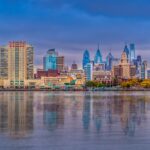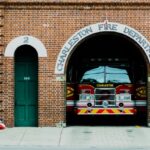Being one of America’s oldest cities, New York has several historical sites to keep tourists entertained. There are many old pubs, historic parks, Eilis Island, and the Statue of Liberty to view, as well as Grand Central Station, the transportation centre that connects you to all of the fascinating historical attractions both inside and outside of New York City (NYC).
Welcome to our blog on historical sites in New York! Here, we’ll discuss some of the most important and iconic historical sites in the city, as well as provide tips on how to visit them. Whether you’re a history buff or just looking to add a new destination to your list of places to see, we hope you’ll find our blog helpful.
Here is a comprehensive list of twenty (20) most iconic historical sites in New York to visit:
1. Statue of Liberty
The Statue of Liberty has secured its standing as the ultimate emblem of New York City since it was donated to the United States by France in 1886. The statue, designed by the same architect who designed the Eiffel Tower, is one of New York City’s most popular historical attractions, drawing millions of visitors each year. It is often regarded as a symbol of American liberty and pride.
This statue totally made of copper was such a big deal back then. And also, just the construction and funding of the statue is a fascinating piece of history in and of itself.
Of course, you may see the statue right now by taking a boat ride from Manhattan. There is a museum and information boards where you can learn all about how the city’s most recognizable emblem came to be, as well as experience some spectacular views of New York!
If you’re on a budget, you should opt for the Staten Island ferry to get a good view of the statue; it’s free, but if you can, include it on your agenda!
2. Eilis Island
Eilis Island is just in proximity to Liberty Island, so move right from viewing the Statue of Liberty and board a ferry to Eilis Island, where over 12 million immigrants were processed and welcomed to America throughout the 1890s and 1900s.
The Eilis Island National Museum of Immigration, which is housed in the old Main Building of the immigration station complex, first opened its doors in 1990.
The edifice has been rebuilt to its original appearance from 1918 to 1924, allowing visitors to relive the experience of immigrants passing through the requisite inspections before being allowed to enter America.
Today, many Americans can retrace their ancestors’ footsteps by visiting Eilis Island. Visitors can also look up and print out historical documents of their relatives who came through Eilis Island.
Intrepid Sea, Air & Space Museum
This NYC historical monument boasts an unrivaled collection of American fighter ships and planes atop a real decommissioned aircraft carrier, which is sure to appeal to WWII history buffs. The Intrepid, which is stationed at Pier 86 on Manhattan’s west side, fought in the Pacific during WWII, surviving kamikaze strikes and a torpedo strike.
A Blackbird spy plane, the Space Shuttle Enterprise, the USS Growler submarine, a Concorde SST, and a capsule that returned one of the first Astro-tourists to earth are among the exhibits on board the ship. With hands-on displays of things used in everyday life and views of the lower living quarters, visitors can get a peek at how naval officers lived aboard the ship.
City Hall Park
The oldest city hall in the United States, New York City Hall, is located in the Civic Center section of Lower Manhattan and still holds its original municipal duties. The original city hall was constructed in 1700, and it was rebuilt in 1812.
City Hall Park, which is adjacent to the structure, has hosted various historical demonstrations and movements, including Stamp Act protests, George Washington’s reading of the Declaration of Independence, and a two-day commemoration of New York’s abolition of slavery.
On July 9, 1776, the Declaration of Independence was read for the first time in New York at this spot and it was a historic occasion. This makes City Hall Park one of the top historical sites in New York.
The old city Commons was also located in City Hall Park. Anyone could graze their animals, collect firewood, and cut turf for fuel on this land.
Today, folks flock to City Hall Park to unwind, eat lunch, and bask in the sun on the green lawns.
Trinity Church
Trinity Church, in the Financial District of Lower Manhattan, was founded in the 17th century and is located at the confluence of Broadway and Wall Street. It is one of New York City’s earliest Gothic Revival structures, and the accompanying cemetery is home to many famous Americans, including its founding father, Alexander Hamilton, and Francis Lewis.
The current Trinity Church on Broadway isn’t the first. This honor is bestowed upon a structure constructed in 1698 by a small group of Church of England devotees. It was used for a while, but it was destroyed in the Great New York City Fire of 1776. When significant snowfalls compromised the structural integrity of its replacement, it was replaced again.
On Ascension Day, 1846, the current church was dedicated. For a time, it was the tallest building in the United States, but in 1869, it was surpassed by St Michael’s Church in Chicago.
More recently, during the horrific events of September 11, 2001, the cathedral served as a haven. Passers-by crowded themselves into the church to avoid falling debris.
Times Square
Longacre Square, named after London’s carriage district, was renamed Times Square in 1904 when the well-known newspaper The New York Times moved in.
Times Square is one of the historical sites in New York that is one of the most well-known tourist attractions, not only because it is a significant center of the global entertainment industry, but also because it is one of the busiest pedestrian zones in the world.
In reality, it has been largely devoid of automobiles since 2009. An estimated 340 000 people pass through the Square on an average day, with 450 000 passing through on the busiest days.
Visiting Times Square during the day is a memorable experience in and of itself, but it truly comes alive at night.
The ancient ball drop tradition attracts thousands of tourists and locals every New Year’s Eve, making it one of the most popular times to visit. The first ball drop occurred in 1907, making the popular event more than a century old.
Central Park
Central Park, is located between Manhattan’s Upper West and Upper East Sides and is New York’s most famous urban green space. The park is larger than the entire country of Monaco.
Central Park, like many of the historical sites in New York, is a picturesque location that has been featured in films and television shows. It is, in fact, the most filmed place on the planet. Central Park is the subject of a musical adult animated television series in the United States. Oh, and don’t forget about Central Perk, the infamous coffee shop from the TV show Friends.
Despite the fact that it is larger than a country, it is only the city’s fifth-biggest park but it is more noteworthy for its historical significance and the presence of some of North America’s largest and last remaining American Elm Trees.
Broadway Theater
In 1750, almost 300 years ago, Walter Murray and Thomas Keane opened the first Broadway theater. Shakespearian plays and operatic theater were the mainstays of the theater’s repertoire. Since then, the Theater District has evolved into one of the most dazzling entertainment districts as well as one of the historical sites in New York.
The Theater District, also known as Broadway, is a collection of 41 professional theaters in Midtown Manhattan, each with a seating capacity of at least 500 people. Some of the most famous Broadway performances, include The Phantom of the Opera, Les Miserables, West Side Story, Kinky Boots, and many others and you can still drop by to see them.
St Paul’s Chapel
St Paul’s Chapel was just a few blocks from Trinity Church and was opened in 1766, to its first worshippers. On September 21, 1776, the “Great Fire” that destroyed Trinity Church happened but St Paul’s chapel miraculously survived. To douse the flames, people formed a human chain and passed buckets of water from the Hudson River. The “Bucket Brigade” was their nickname. It is now the city’s oldest public building in continuous use, as well as one of the most important historical sites in New York.
During the attacks of 9th September, it stood firm once more, earning the nickname “The Little Chapel that stood.” A sycamore tree in the churchyard is considered to have taken the brunt of the attack.
Artist Steve Tobin later based a sculpture named the Trinity Root on the fallen tree, which stood in the churchyard for a time. The Bell of Hope, cast in London’s historic Whitechapel Foundry, is rung to commemorate the event each year.
The Metropolitan Museum of Art
The Metropolitan Museum of Art, founded in 1870 and located on Fifth Avenue in Manhattan, is a symbol of history and art.
It is one of the largest and most beautiful museums in the world, with over 2 million works of art divided into 17 curatorial departments.
The Metropolitan Museum of Art has hosted hundreds of exhibitions, both historic and modern, ranging from surrealism to Native American heritage, for over 150 years.
Asides from being one of the most popular historical sites in New York, The Metropolitan Museum of Art, popularly known as The Met, is well-known for hosting the annual Vogue Met Gala. Eleanor Lambert, a fashion publicist, founded the Gala in 1948, and it has taken place every year since. Celebrities, members of New York’s high society, and professionals in the fashion business are usually among the attendees.
Wall Street
The United States’ financial core has become known as Wall Street. It is home to many of the world’s greatest financial institutions, as well as the New York Stock Exchange.
On April 30 of 1789 which was the morning of the Presidential Inauguration, people lined Wall Street and cheered General George Washington as he went up Wall Street to the site where Federal Hall currently stands. This deed is considered significant, and the street is now a historical landmark in New York City.
The Brooklyn Bridge
The Brooklyn Bridge, which connects Manhattan and Brooklyn, was built in 1883 and was the first roadway to cross the East River.
Prior to this, Brooklyn was considered a separate city and was not included in the New York City metropolitan area.
With a central span of 486 meters (1595 feet), the hybrid cable-stayed suspension bridge was the world’s longest suspension bridge at the time. It was also the first suspension bridge in the world to use steel cables instead of iron.
Thousands of automobiles, bicyclists, and pedestrians pass through the bridge every day, but it wasn’t always that way. Before now, from around 1883 to1908, only Cable vehicles crossed the bridge, then elevated trains began to be used until 1944, and finally trolleys until 1954.
The stunning Brooklyn Bridge is one of the most instagrammable and iconic historical sights in New York and is also one of America’s most striking bridges.
Bowling Green Park
Bowling Green is one of the historical sites in New York to stop by on your tour as it is the oldest park in New York City.
It’s widely assumed to be the location where Peter Minuit paid “60 guilders” for Manhattan in 1626.
It began as a livestock market and a gathering place for people. In 1733, it was designated as a park.
After promising to plant trees and lay sod to make the site more pleasant for pleasure, John Chambers, Peter Bayard, and Peter Jay leased the land for a nominal rent.
A statue of King George II was constructed in 1770, but the ill-fated monument did not live long. Some Patriots stormed down Broadway to Bowling Green and tore it down after General Washington’s speech in 1776 at the City Commons. The City Museum of New York on the Upper East Side has parts of the statue.
Many of the gate pillars’ iron crowns were also pulled off by the Patriots. The original gate, which was built in 1776, remains to encircle Bowling Green Park today.
Fraunces Tavern
Fraunces Tavern, one of New York’s oldest and most famous taverns, is a must-see for history buffs in Manhattan because it was once a popular meeting place for several of America’s Founding Fathers!
George Washington stood outside Fraunces Tavern in December 1783, at the end of the Revolutionary War, giving an impassioned farewell message to a group of his commanders, saying that the last of the British forces had withdrawn and it was time to return home.
The structure was built in 1719 and has served as a private dwelling, hotel, and bar throughout its existence. Today, you may swing by for a pint or pay a visit to the museum to learn more about this Financial District institution.
The Tenement Museum
The Lower East Side Tenement Museum is a National Historic Site that tells one of the most important American stories by providing an insight into the lives of numerous immigrants. Tenement Housing was once one of the most common settling grounds for many immigrants arriving in America until it became a museum.
The low rent contributed to the area’s appeal among immigrants. Many low-rise structures with multiple narrow-structured, mainly 3-bedroom flats were found in the neighborhood. It was not unusual for a family of ten or more to cram into one of these apartments.
Grand Central Station
Throughout the 1800s, New York City required a transportation hub to match the bustling metropolis that was bursting at the seams with culture, industry, and innovation. Grand Central Terminal’s opulence became the ideal landmark to welcome long-distance railroad passengers to the city.
Today, the concourse has been expertly restored to its 1913 glory, with over 20 restaurants, cocktail bars, and casual diners, as well as 50 specialized stores and transportation alternatives to get you around Manhattan and the boroughs beyond.
National September 11 Memorial and Museum
Like most historical sites in New York City, this one has a long history and a heartbreaking story to tell.
September 11th, 2001 is remembered as one of the worst days in history, not just for America but for the entire globe.
The National 9/11 Memorial & Museum is a lovingly organized memorial and museum to one of history’s darkest days, with many artifacts, images, and personal tales from first responders, survivors, and family members of the victims of the Twin Towers, Pentagon, and Somerset County, Pennsylvania.
The Twin Towers were hit by four coordinated terrorist assaults on September 11, 2001. Almost 3000 people were killed, nearly 6000 were injured, and millions were displaced as a result of the disaster.
Take a tour of the National 9/11 Memorial & Museum to honor those who were killed or whose lives were forever changed as a result of the attacks.
Take a walk around the vast reflecting ponds where the towers once stood, listening to the rushing water from North America’s greatest man-made waterfalls and reading the names engraved on the memorial.
To memorialize those victims whose birthdays occur on your visiting day, place a white rose near their names.
Inside the museum, you’ll uncover historic remains from the World Trade Center site, such as plane parts, mangled steel beams, and the stairs (now known as the Survivors’ Stairs), which survived the impact of the skyscraper’s collapse and served as an escape for hundreds of survivors who fled the structure.
This museum should not be missed if you are visiting NYC. It is a genuinely dismal and poignant experience.
Federal Hall
Walking the halls of the site where George Washington took the oath of office as the nation’s first president should be on your list of things to do during the tour of the historical sites in New York.
The first Congress and the first Supreme Court were both held at Federal Hall National Memorial on Wall Street. The Washington Inaugural Gallery is one of the most interesting exhibitions on the grounds, with the actual bible that Washington used to swear in as president on display, as well as a stone slab from the balcony where he stood on that fateful day in April 1789.
The current structure, which was built in 1842 as a Customs House, was originally built in the early 18th century to serve as City Hall. It has also served as the nation’s Sub-Treasury, with vaults in the basement containing millions of dollars in gold and silver.
The Empire State Building
This art deco skyscraper is one of New York City’s and the world’s most recognizable structures! From its construction in 1931 through the opening of the World Trade Center in 1970, it was the world’s tallest structure.
The 102-story structure houses two famous observation decks that provide unobstructed city vistas to millions of visitors each year and has been featured in numerous films and pop culture references, including King Kong and Sleepless in Seattle.
Stone Street
What is now the present-day Stone Street, in the early 1600s formerly had the first paved roads in New York running through it.
Stone Street, as it is currently known, offers visitors a glimpse into what a street in 17th-century New York City looked like.
It is now a popular meeting place for Wall Street bankers and social events.
Conclusion
When you think about this great city, it’s difficult to pinpoint just one standout feature. It’s practically impossible to see all the historical attractions in New York and do everything there is in a day. The city has enough thrill and adventure to offer not only tourists but also locals.
There is a limitless assortment of activities to keep you building memories that last a lifetime, whether you are a history buff, an adrenaline junkie, a shopaholic, or a foodie.
New York may be known for its tall buildings, theaters, and buzzing with a large working-class population, activities, and life, but there is another side to the city – its long, rich, loud, and proud past!
You must have known that from 1785 to 1790, New York City was the nation’s capital. The Founding Fathers were constructing the groundwork and establishing significant government offices, such as the first Congress, Supreme Court, and Executive Branch posts, during this time.
It is a city that is well-known for a variety of reasons. Not only is it one of the most well-known cities in the world, but it is also home to many historical structures and markers, as well as some of our favorite TV shows, such as Friends, Sex and the City, and Sesame Street, which are frequently shot in New York’s historical sites.



























